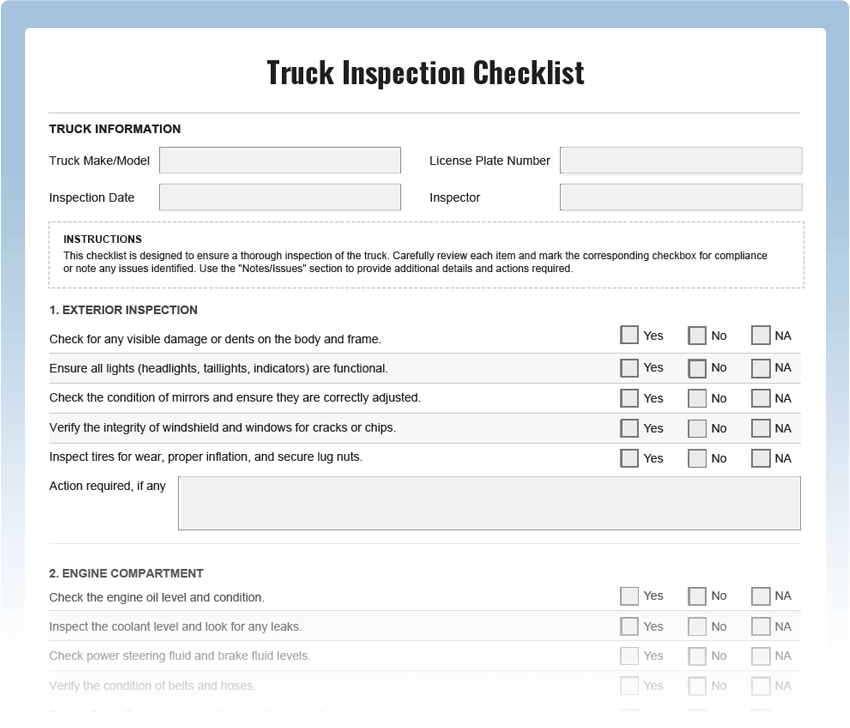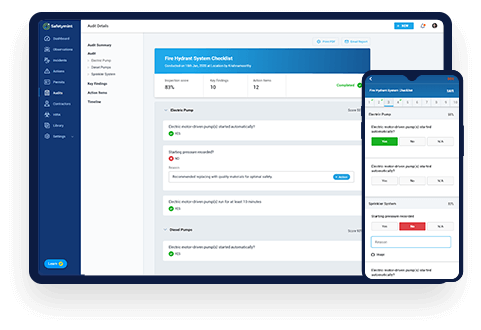Truck Inspection Checklist
Ensure the safety and reliability of your trucks with our comprehensive Truck Inspection Checklist. This free PDF template covers all crucial aspects of a thorough truck inspection, empowering you to identify potential issues and maintain a fleet of roadworthy vehicles.
Digitize this Checklist on Safetymint
- Create unlimited, customized checklists
- Add Actions, with automated reminders
- Works seamlessly with or without internet
- Access via web browsers, mobile or tablets

What is a Truck Inspection Checklist?
A Truck Inspection Checklist is a systematic tool used to assess the condition and safety of trucks. It encompasses a series of checkpoints designed to evaluate various components, ensuring that trucks meet safety standards and regulatory requirements. Regular truck inspections are essential to prevent accidents, optimize performance, and comply with transportation regulations.
Key Things to Inspect in a Truck:
- Braking System: Check the brake pads, rotors, and brake fluid levels to ensure the brakes are functioning correctly.
- Tire Condition: Inspect tire tread depth, sidewalls, and tire pressure to prevent blowouts and improve fuel efficiency.
- Lights and Signals: Verify the proper functioning of headlights, taillights, indicators, and emergency flashers for optimal visibility on the road.
- Fluid Levels: Check engine oil, transmission fluid, coolant, and other fluid levels to prevent mechanical failures.
- Steering Mechanism: Ensure the steering wheel and system are responsive and aligned correctly for safe handling.
- Electrical Systems: Inspect the battery, alternator, and wiring to avoid unexpected breakdowns.
- Exhaust System: Check for leaks and emissions to comply with environmental regulations.
- Safety Equipment: Ensure that safety items like reflective triangles, fire extinguisher, and first aid kit are present and in good condition.
Common Truck Inspection Hazards:
Trucks can encounter various hazards that may compromise safety and efficiency. Common hazards include:
- Brake Malfunction: Faulty brakes can lead to accidents and increased stopping distances.
- Tire Blowouts: Worn-out tires are susceptible to blowouts, resulting in potential accidents.
- Electrical Failures: Electrical issues can lead to sudden breakdowns and disruptions.
- Visibility Problems: Malfunctioning lights reduce visibility, increasing the risk of collisions.
- Overloading: Overloading a truck may lead to stability issues and damage to the vehicle.
Truck Inspection Best Practices:
- Routine Inspections: Conduct regular inspections, including pre-trip and post-trip checks, to catch and address problems promptly.
- Driver Training: Ensure drivers are trained to perform basic inspections and report any issues.
- Maintenance Records: Keep detailed maintenance records to track truck performance and identify recurring problems.
- Compliance with Regulations: Stay updated with transportation regulations and comply with inspection requirements.
- Safe Loading Practices: Educate drivers on proper loading techniques to prevent overloading and ensure cargo security.




